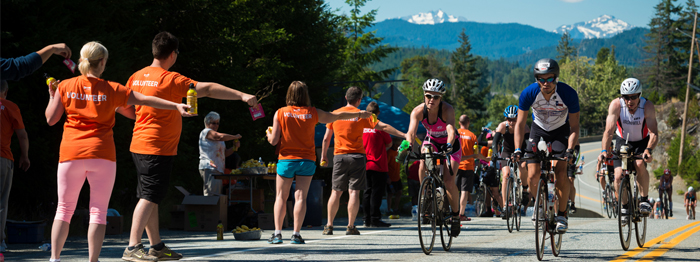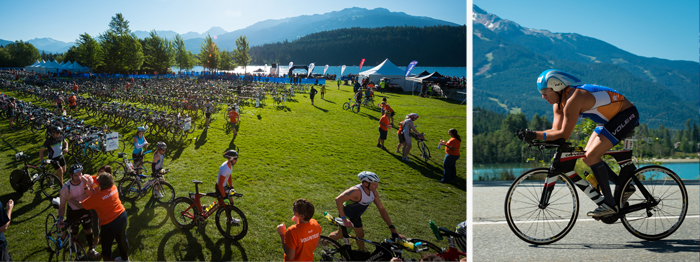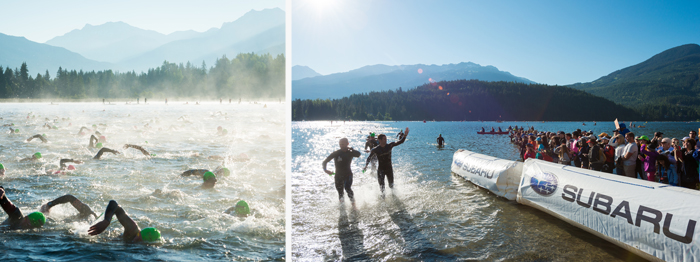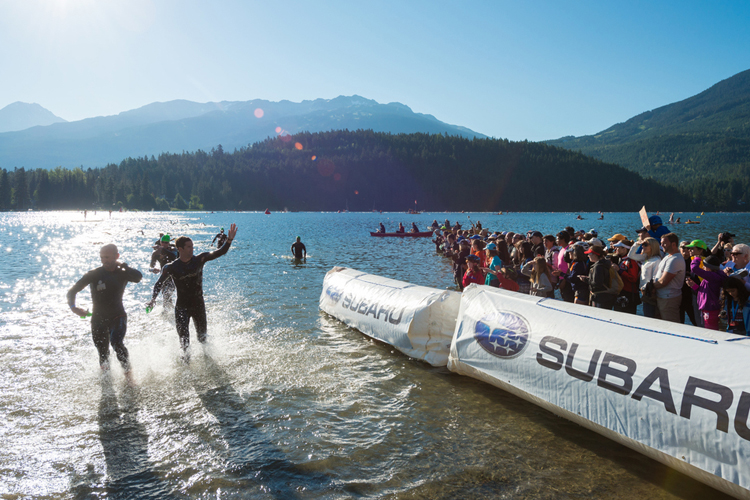Updated: Whistler no longer hosts IRONMAN® Canada, but there are plenty more challenging events throughout the year to test your mettle.
Guest Author: Andrew Mitchell

It isn’t the easiest race to watch in person. With a 225+ km swim/bike/run course that can take anywhere from 8 to 17 hours to complete spanning from the Callaghan Valley south of Whistler to Pemberton in the north, the Subaru IRONMAN® Canada makes for a long day, especially for the athletes.
But while the Whistler course is recognized as one of the hardest in the world with more ups, downs, twists and turns than other events, a two-lap swim section and out-and-back courses on both the bike and run offer some decent opportunities for spectators to get a good look at the action and cheer on the athletes. The Whistler Visitor Centre in Whistler Village is an excellent resource for maps and information once you arrive in town, but until then here’s an Insider’s guide to watching the show:
Event Details
Subaru IRONMAN® Canada in Whistler takes place Sunday July 30, 2017 on the very same day as the shorter Subaru IRONMAN® Canada 70.3 race.
We’re focusing on the longer race in this guide. The official Spectator Guide (available to view and download online now) covers both races.
The Course
Swim Course
- Things kick off with the 3.8 km (2.4 mile) swim leg at Rainbow Park. Pro women start at 6:40 AM, pro men five minutes later, and the age groups at 6:50 AM.
- There are a number of cut-offs on the Whistler course, starting with the swim. Anyone still in the water at two hours and 20 minutes will not be allowed to continue.

Bike Course
- The 180 km (112 mile) bike leg also begins at Rainbow Park.
- Cyclists will head north on Alta Lake Road, and then veer east on Alpine Way for a quick jaunt to Highway 99. Athletes will then ride southbound through Whistler to the Callaghan Valley Road, where they will make a loop up to Whistler Olympic Park (the Nordic sports facility for the 2010 Winter Games) before returning to the highway for a long northbound ride all the way to the Rutherford Creek turnaround.
- Here, cyclists will turn around and ride south through Pemberton, back to Whistler Village and the bike-run transition at Parking Lot 4.
Run Course
- The 42.2 km (26 mile) running leg takes the runners around Lost Lake, and then out to the lookout on Green Lake before doubling back towards the Village. After the second loop, they’ll be directed to the finish line next to Whistler Olympic Plaza – hopefully before the midnight cut-off.
Getting Around On Race Day
With all the race traffic and some planned road closures the best spectator strategy is to ditch your car in favour of a bike or walking. There is limited vehicle access if you have mobility issues, but bikes can go anywhere and will probably get you there faster. The Spectator Guide has excellent tips on where to watch, and routes to and from the Village that avoid highway and road closures.
Whistler transit buses will be free from first service on Friday 28th through last service Sunday 30th – they’ll be running on a modified schedule as per their website.
It’s also highly recommended to stay in Whistler Sunday night to catch the action as the last competitors race to beat the midnight cut-off. This also helps avoid any Sunday afternoon traffic back to Vancouver. Check out the times and locations of road closures in this Travel/Traffic Guide.

What to Bring:
Watch the weather reports. Rain gear might be in order, and warmer clothes as mountain temperatures can drop a bit in the mornings and evenings. Pack sunscreen and a hat. Bring something to eat, something to drink, and some cash to pick up coffees and snacks along the way. Bring something to make noise with, road chalk, inspirational signs or anything you think might make athletes smile. If a whole day on your feet sounds a bit much, bring a folding chair.
Where to Watch
The Swim
It’s early! This is a must-see: mist drifting up off the lake, the sun rising over Whistler Mountain, and a mass start that turns the lake water into foam. The first pros are out of the water in just over 50 minutes.
There’s not much room on the docks, so get there early to snag a spot. Some spectators will bring hip waders or just stand in the water in their swimsuits. The best place to be, if you can manage it, is out on the water with a canoe, kayak, or stand up paddleboard. Obey the course marshals though.

The Bike
Your best, and most convenient option post-swim, is to take the Valley Trail north to Meadow Park and Highway 99. If you hang out for a while, you’ll see some of the slower swim athletes pedaling south, and the faster athletes hammering north to Pemberton — and back. And if you feel like hanging out all day, you’ll even see the runners go by on the Valley Trail across the road a total of four times!
If you’re looking to cheer on specific athletes, or watch the leaders battle it out, follow the Valley Trail back around the golf course to Whistler Village and hit up the second transition spot in Parking Lot 4. The leaders should be coming in just after noon.
The Run
Because the course follows an out-and-back route there are a lot of great places to watch inside Lost Lake Park, out at Nicklaus North (the wood bridge section is particularly scenic), or anywhere along the course that heads north from the bridge. If you feel like pedaling, the lookout and turnaround spot on Green Lake is a spectacular place to cheer on runners and also makes for beautiful sunsets.

The Finish
Regardless of why you come out to watch Subaru IRONMAN® Canada, it’s essential to stick around at the finish to watch the last racers come in before the midnight cut-off. Most of the athletes make a point of coming back to cheer on the people who suffered through the hardest, longest, most painful of days, but didn’t give up. It’s a fun and inspiring vibe, to say the least.
For more info and tips on Subaru IRONMAN® Canada, check out the official Spectator Guide as well as that Travel/Traffic Guide we mentioned before. And you can always find accommodation info or any other Whistler data you need at Whistler.com



